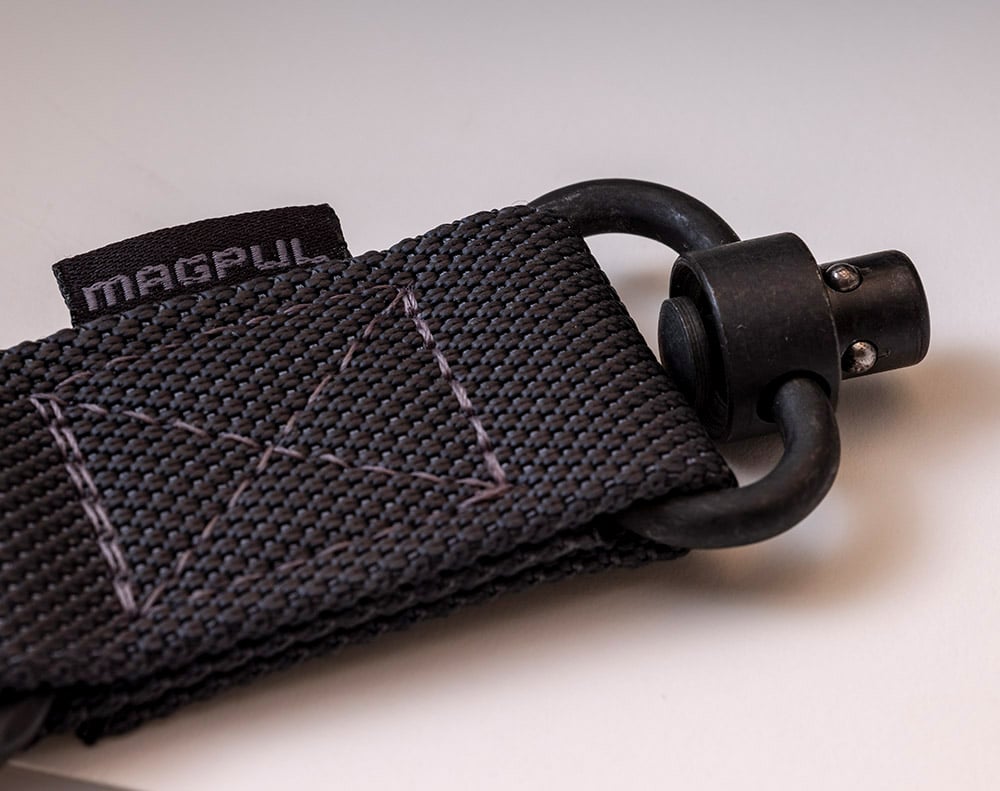Up to now, I’ve never found a good solution for managing large lenses in the field. You want to be able to sling the camera and lens over your shoulder for easy carrying, but, especially when you’re using a tripod, a strap is an encumbrance. If you or a bystander catch your hand in it, having a strap can be dangerous to your gear. So some kind of quick-disconnect system is in order. I’ve switched my camera straps over to the Peak quick-disconnect system. That works fine with light lenses, but I don’t think it’s strong enough for me to trust it with a really big lens. In addition, attaching the Peak lugs to big lenses without impeding the mounting and unmounting of the lens to Arca-Swiss-compatible heads is difficult at best.
For some time now, Really Right Stuff has been incorporating into their plates receptacles for a quick-disconnect system created for firearms. It goes by the unimaginative moniker QD. Here’s a picture of the strap end:
The round barrel on the right slips into a hole on the RRS plates. The shiny round protuberances from the barrel comprise the locking mechanism. When you press the rounded button on the left side of the strap’s D-ring, the locks retract, and you can insert the barrel into the plate, or remove it from there. It takes less than a second to snap it in or pop it out. My first worry was that it would be too easy to inadvertently release the lock, resulting in thousands of dollars worth of gear descending swiftly to a concrete floor. After I’d used the system a while, I realized that the D-ring protects the button from being depressed when the gear is hanging from the strap. I suppose it would be possible to get a tool in there while the camera is on your shoulder, but you’re not going to be able to release it with your thumb or a finger unless you rotate the barrel upwards or downwards, assuming the orientation shown above.
RRS sells Magpul straps, but there are many other options to choose from. The straps RRS sells have both male and female connectors. If you want to clip into just one camera plate, you clip the strap to itself like this:
But, with big lenses, I don’t like one point of connection to the camera/lens system. Doing it that way lets the camera swing around too much. I like to clip one end of the strap to the camera plate and the other one to the lens plate, as is illustrated with this shot of an a9 and the Sony 100-400 lens:
Note the black and red Peak lug, for use when I’m using the camera with small lenses. After using the QD system for a few days, I’m sold on it. It is secure. It will handle a lot of weight. I’ve tried unsuccessfully to get it to release by itself. You can pop the strap loose as you swing the camera onto a tripod and lose hardly any time.
It still makes me a little nervous to walk around with the camera over my shoulder held in place only by a connection that is so easy to make and break when that is your intent, but I’m getting used to that.



I prefer the spider holster and I used a fish bone clamp with a ball for the holster attached to it. I also have a Fisk bone clamp with a strap attached to it if I choose to not use the holster. Any clamp 30mm or smaller is my preference, the fiskbone doesn’t work well if you have stops in the plate. With this setup I have a plate always attached to it and I just pick the clamp I want to use; tripod, strap, or holster.
Are you still using this system and happy with it.
I’ve recently moved from manfrotto plates to Arca so I can look into the QD straps.
In your photo above how secure is the strap adjuster on left hand side? What stops it from just sliding through completely?
Thanks
There is nothing to stop the strap from sliding thru completely if the buckle fails. If you’re worried about that, a few stitches should prevent it. I still use this for big lenses. It has worked just fine.
I’ve used QD on everything for a year ear now. Love it. Nikon D6, Nikon D5, Nikon D850, 400/2.8, 300/2.8, 200-400/4, 120-300/2.8, fuji x-t2 – everything is running RRS QD capable arca plates. Black. Have two of the magpul ones you show here plus two separate styles of two camera shoulder straps from Black Rapid too. I replaced the black rapid clips they use for their screw in tripod adapters with magpul QD male couplers by unstitching, removing the old, adding the new magpul ones, then restitching so my stuff is one offed – but I’m thrilled with it.
There is some evidence on the web of tripod mount or bottom plate failure when the camera is carried upside down. Roger Cicala’s remarks about the Nikon Z7’s tripod mounting plate aren’t overly encouraging (https://www.lensrentals.com/blog/2018/10/teardown-of-the-nikon-z7-mirrorless-camera/). I look at the tiny screws that hold the mounting plate in place and get nervous. Am I being neurotic? After all, there are legions of people who use sling straps all the time.